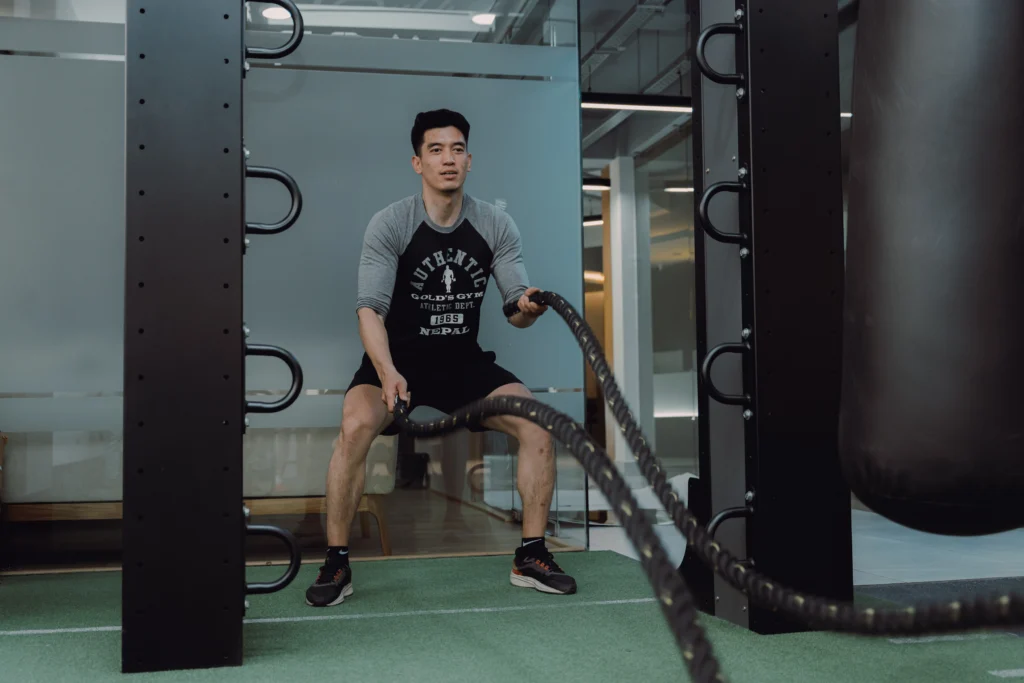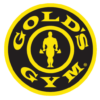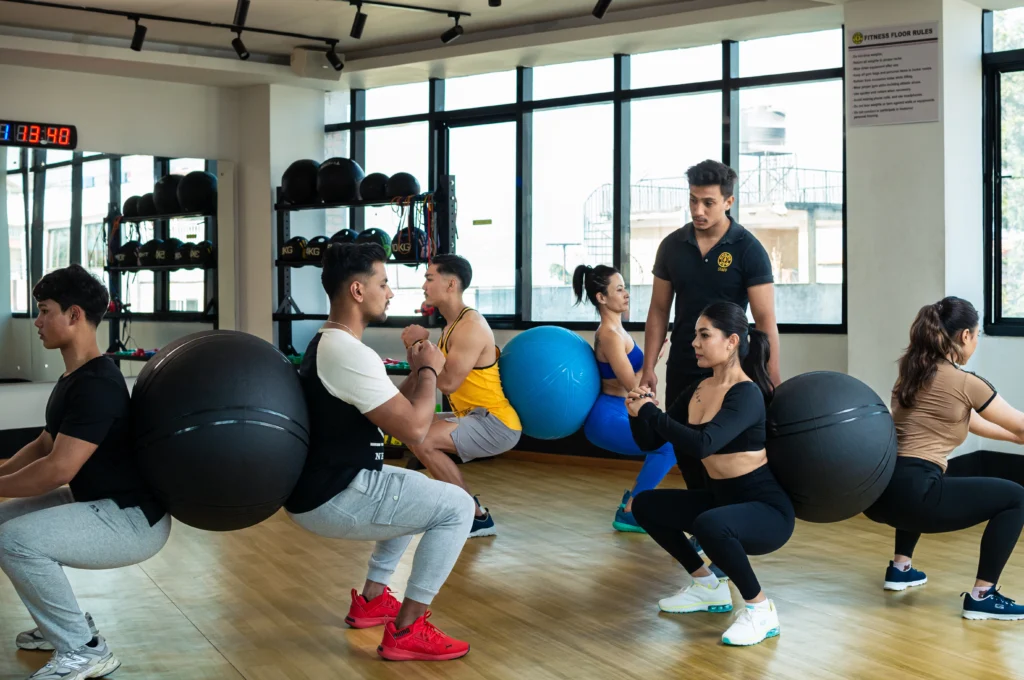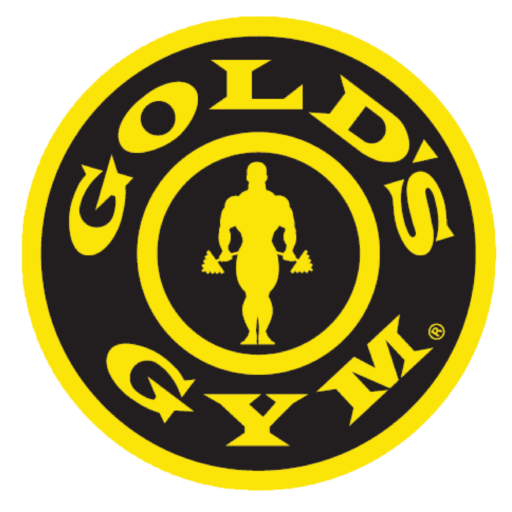Fitness trends come and go, but one movement seems to be here to stay: functional fitness. It’s not just about lifting the heaviest weights or running the fastest miles anymore. Instead, the focus has shifted towards training movements that mimic real-life activities.
In this blog, we’ll explore the latest trends in functional fitness, their benefits, and how you can incorporate them into your workout routine.
What is Functional Fitness?
Functional fitness is a type of exercise that focuses on improving the body’s ability to perform everyday activities. It involves multi-joint, multi-muscle exercises designed to mimic natural movement patterns like pushing, pulling, lifting, and squatting for enhancing strength, stability, flexibility, and balance.
Origin of Functional Fitness
The idea of Functional Fitness has been around for a while, popping up in different training styles throughout the 1900s. But it wasn’t until the 1990s that the term “Functional Fitness” really caught on. This is largely thanks to Greg Glassman, who created a very popular training method.
Glassman was one of the first to say that training should help people get better at everyday activities, both physically and mentally. He believed that exercises should prepare you for real-life situations, not just make you look good. Functional Fitness is all about getting your body ready for the challenges you face in your daily life.
Why is it gaining popularity?
Functional fitness is becoming popular for its focus on real-life movements, versatility, and adaptability. It enhances overall strength, balance, and injury prevention, making it suitable for all fitness levels.
Real-Life Movement
Functional exercises are rooted in movements people perform in their daily lives, such as bending, twisting, and lifting. This makes them incredibly practical and effective.
Versatility and Adaptability
These exercises can be performed anywhere—at home, outdoors, or in a gym—using minimal equipment.
Injury Prevention
Functional exercises improve balance, posture, and stability, reducing the risk of injury in both workouts and everyday life.
Inclusive for All Levels
Whether you are a beginner or an advanced fitness enthusiast, functional fitness can be tailored to your fitness level.
Key Trends in Functional Fitness
Body Weight Training
Bodyweight exercises like push-ups, squats, lunges, and planks are key to functional fitness, enhancing strength, balance, and flexibility. These exercises are simple yet effective and can be easily adjusted to suit all fitness levels, making them perfect for on-the-go workouts. With certified trainers, you can get guidance on mastering bodyweight training and achieving your fitness goals.
HIIT (High-Intensity Interval Training)
HIIT has revolutionized the fitness industry with its time-efficient and result-driven approach. This method alternates between short bursts of intense exercises and brief recovery periods, effectively boosting cardiovascular endurance, burning calories, and building lean muscle mass.
CrossFit Dominance
CrossFit combines weightlifting, high-intensity cardio, and functional movements to create a well-rounded and challenging workout experience. Known for its community-driven culture, CrossFit emphasizes measurable progress, allowing participants to track their strength, endurance, and agility improvements. It promotes not just physical strength but also mental resilience
Group Fitness Classes
Group workouts have gained immense popularity for their motivational and social aspects. Exercise in a group setting creates a sense of accountability and support, encouraging participants to stay consistent with their routines. Group Fitness Classes offered by expert instructors ensure proper technique and minimize the risk of injury.

Kettlebell Training
Kettlebells have become a favorite tool in functional fitness due to their versatility and effectiveness in building strength, endurance, and mobility. Exercises like swings, snatches, and Turkish get-ups target multiple muscle groups and improve coordination and stability.
Yoga & Pilates
Yoga and Pilates, though not always linked to functional fitness, are powerful tools for enhancing flexibility, core stability, and body awareness. Both practices improve balance and alignment, complementing strength training for a well-rounded fitness routine.
You can find various shifts of yoga classes at Gold Gym Nepal that fit your schedule, helping you achieve a balanced and injury-resistant workout.
Role of Technology in Functional Fitness
Technology has revolutionized functional fitness by providing advanced tools for tracking progress, improving workouts, and enhancing results. Here are some roles of technology in functional fitness:
Wearable Fitness Tech
Wearable fitness technology, like smartwatches and fitness trackers, plays a significant role in monitoring health metrics during functional workouts. These devices track heart rate, calories burned, steps taken, and even sleep patterns, offering valuable insights into a user’s fitness levels and helping them optimize their routines.
Virtual Fitness Platform
Virtual fitness platforms bring functional fitness to users’ homes, offering on-demand or live-streamed workout sessions. These platforms provide flexibility and convenience while connecting individuals with trainers and fitness communities.
Role of Nutrition In Functional Fitness
Nutrition plays a vital role in functional fitness by providing the body with the necessary fuel to perform, recover, and improve. Here are some roles of nutrition in functional fitness:
Personal Nutrition Plan
A personalized nutrition plan is the most effective way to support your fitness journey. Tailored to your specific goals, whether it’s building muscle, increasing endurance, or losing weight, a custom nutrition plan addresses your unique needs.
At Gold Gym Nepal, you can have a certified nutritionist who will guide you in creating a personalized nutrition plan that aligns perfectly with your fitness goals.
Focus on Protein-Rich Diets
A protein-rich diet is crucial for anyone engaging in functional fitness, as protein plays a key role in muscle repair and growth. After a tough workout, protein helps rebuild muscle fibers, improving strength and preventing injury. By incorporating high-quality protein sources like lean meats, fish, eggs, and plant-based options into your diet, you ensure that your body has the building blocks it needs for recovery.
Benefits of Functional Fitness
Functional fitness offers a wide range of benefits that go beyond just improving your workout performance. Here are some of the benefits of functional fitness:
Improve Daily Performance
One of the key benefits of functional fitness is its ability to improve your daily performance. By training movements that mimic real-life activities, you enhance your body’s ability to perform tasks like lifting, bending, or carrying with ease.
Improve Cardiovascular Health
In addition to improving daily performance, functional fitness also has significant cardiovascular benefits. Engaging in exercises that activate large muscle groups elevates the heart rate, promoting better circulation and overall heart health.
Injury Prevention
Functional fitness also plays a crucial role in injury prevention. By strengthening muscles, improving flexibility, and enhancing joint stability, these exercises help prepare the body to handle the stress of daily movements and reduce the risk of injury.
Enhance Core Strength
Core strength is essential for maintaining good posture, stability, and overall functional movement. Functional fitness exercises target and strengthen the core muscles, which play a critical role in almost every movement you make.
How to Start a Functional Fitness Routine
Starting a functional fitness routine is a great way to improve your strength, flexibility, and overall health. Here’s a simple guide to get you started:
- Assess Your Fitness Level: Evaluate your current strength, flexibility, and balance to identify areas for improvement.
- Set Clear Goals: Establish specific, measurable fitness goals to stay focused and motivated.
- Start with Basic Movements: Begin with foundational exercises like squats, lunges, and push-ups to build strength and mobility.
- Incorporate Variety: Include a mix of exercises targeting different muscle groups to keep your routine effective and engaging.
- Start Slow and Progress Gradually: Begin with low intensity and gradually increase difficulty to avoid injury and allow your body to adapt.
- Stay Consistent: Aim for 3-4 sessions per week for steady progress and better results.
- Consider Professional Guidance: Work with a trainer if needed to ensure proper technique and personalized routines.
By following these steps, you’ll be well on your way to starting a functional fitness routine that will enhance your overall fitness, improve daily performance, and support long-term health.
Must-Have Equipment For Functional Fitness
Having the right equipment is essential for maximizing your functional fitness routine. These tools help improve strength, endurance, and mobility, making your workouts more effective. Here are some must-have items for your functional fitness journey:
Kettlebells
Kettlebells are versatile tools that can be used for a wide range of functional exercises. From swings and squats to presses and deadlifts, kettlebells help build strength, endurance, and flexibility while engaging multiple muscle groups simultaneously. They’re perfect for enhancing core stability, improving posture, and developing functional power.
Medicine Balls
Medicine balls are great for explosive movements and core-strengthening exercises. They can be used for exercises like slams, throws, and rotational movements that mimic real-world activities. Their ability to target both upper and lower body muscles makes them a must-have for improving functional fitness and coordination.
Battle Rope
Battle ropes are ideal for building endurance, power, and upper-body strength. The waves, slams, and other movements you perform with battle ropes engage your core, arms, and shoulders while also improving cardiovascular fitness. This tool is perfect for adding high-intensity, functional exercises that mimic real-world tasks and movements.

TRX System
The TRX system is a suspension training tool that uses body weight for resistance. It’s highly effective for building core strength, stability, and functional movement patterns through various bodyweight exercises.
You will get access to all of the above equipment along with other specialized tools for functional fitness, like dumbbells, stationary bicycles, treadmills, elliptical trainers, and more, at Gold Gym Nepal to enhance your training, improve performance, and reach your fitness goals.
Functional Fitness for Different Age Groups
Functional fitness is beneficial for individuals of all ages, as it helps improve strength, mobility, and overall health. Here are some functional fitness exercises tailored to different age groups:
Functional Fitness for Kids
For children, functional fitness promotes healthy growth, coordination, and agility. Activities like jumping, climbing, and balancing not only build strength but also foster a positive attitude toward physical activity, laying the foundation for a healthy lifestyle.
Functional Fitness for Adults
For adults, functional fitness helps improve daily performance by strengthening muscles and enhancing flexibility. It supports better movement in everyday tasks, such as lifting and bending, and helps prevent injuries, promoting overall health and fitness as you age.
Functional Fitness for Seniors
For seniors, functional fitness is crucial for maintaining independence and reducing the risk of falls. Exercises that focus on balance, strength, and mobility help improve quality of life, making it easier to perform everyday activities while managing age-related changes in the body.
Common Mistakes to Avoid in Functional Fitness Training
Functional training offers great benefits, but common mistakes can slow progress and increase injury risk. Avoiding these pitfalls is key to maximizing your results and staying safe.
Neglecting Proper Warm-up and Cool-down Routines
Skipping warm-ups and cool-downs can lead to injuries and slow recovery. Always take time to properly prepare your body before and after workouts.
Using Incorrect Form During Exercises
Incorrect forms can cause injuries and reduce the effectiveness of your exercises. Focus on maintaining proper technique for each movement.
Overtraining Without Adequate Rest
Overtraining without rest can lead to fatigue and muscle strain. Make sure to allow time for your body to recover between workouts.
Ignoring Core Stability Exercises
A weak core can affect balance and posture. Incorporate core exercises to improve stability and overall movement efficiency.
Skipping Proper Nutrition and Hydration
Neglecting nutrition and hydration can hinder performance and recovery. Stay properly fueled and hydrated to support your fitness goals.
Future of Functional Fitness
The future of functional fitness looks bright, with an increasing focus on personalized training and technology integration. As more people recognize the importance of training for real-life movements, functional fitness will continue to grow in popularity. Wearable technology, virtual fitness platforms, and advanced equipment will make workouts more accessible, efficient, and data-driven. Additionally, as awareness about injury prevention and holistic health grows, functional fitness will become an essential part of fitness routines for all age groups. Ultimately, the future of functional fitness lies in its ability to adapt, innovate, and cater to the diverse needs of fitness enthusiasts worldwide.
Conclusion
Hopefully, the above article answers your question on what functional fitness is and why it’s important. Functional fitness isn’t just a passing trend; it’s a lifestyle approach to achieving sustainable health and strength. Whether you’re a gym enthusiast or someone looking to improve your daily life activities, incorporating functional fitness into your routine can lead to long-lasting benefits.
Do You Live Around Lalitpur Area? Book Free Trial Today!!
Get three days of free access to our gym’s exclusive equipment. Enjoy a clean and welcoming environment like never before!
FAQs
What is the main goal of functional fitness?
The main goal of functional fitness is to improve your ability to perform everyday activities with greater ease and efficiency.
Can beginners do functional fitness exercises?
Absolutely! Functional fitness is designed to be accessible to people of all fitness levels, from complete beginners to seasoned athletes.
Do I need special equipment for functional fitness?
No, you don't necessarily need a lot of fancy equipment to get started with functional fitness. However, having some basic types of equipment like: Kettlebells, Medicine Balls, and Battle Rope can certainly enhance your workouts
How often should I do functional fitness workouts?
The optimal frequency of functional fitness workouts varies depending on your individual fitness goals and current fitness level. However, for most people, aiming for 3-4 sessions per week is a good starting point.
Is functional fitness suitable for seniors?
Yes, functional fitness is highly beneficial for seniors. In fact, it can be particularly valuable for older adults as it helps to maintain balance, improve flexibility, and prevent age-related declines in strength and mobility.


